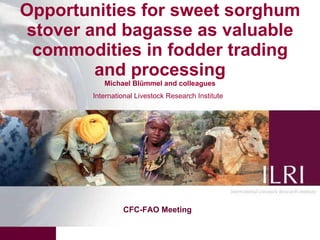Dr Michael Blummel 6 12 2011 ppt
- 1. Opportunities for sweet sorghum stover and bagasse as valuable commodities in fodder trading and processing Michael Bl├╝mmel and colleagues International Livestock Research Institute CFC-FAO Meeting
- 2. Topics Sorghum stover as valuable commodity in fodder markets Opportunities for markets for sweet sorghum bagasse as fodder Value addition to sorghum stover and bagasse through feed processing options and creation of business opportunities and employment Where to go from here: value chain development for sweet sorghum stover
- 4. Sorghum stover trading in Hyderabad
- 5. Changes in grain: stover value in ŌĆśgrainŌĆÖ sorghum from 2004 to 2009 Bl├╝mmel et al (2011)
- 6. Relation between digestibility and price of ŌĆśgrainŌĆÖ sorghum stover Premium Stover ŌĆ£ RaichurŌĆØ Low Cost Stover ŌĆ£ Local YellowŌĆØ Bl├╝mmel and Parthasarathy, 2006
- 7. Price variations in different sorghum stover traded concomitantly in Mieso, Ethiopia, April 2007 Source: calculated from Gebremedhin et al. 2009 Note: In India SS stover have about 3-4 units higher digestibility than GS stover Stover ETB/kg Trader ETB/kg Farm Sweet Sorghum (SS) 0.65 0.20 ŌĆ£ GrainŌĆØ Sorghum (GS) 0.50 0.13 Price premium 30% 54%
- 8. Key findings from sorghum stover fodder trading High monetary value of stover, ratio grain: stover monetary value getting narrower Apparently ŌĆ£smallŌĆØ differences in fodder quality can command surprisingly high price premiums Interesting trans-regional similarities in price premiums
- 9. Opportunities for sweet sorghum bagasse as fodder
- 10. Digestibility of stover and bagasse in a range of sorghum hybrids and varieties (OPVŌĆÖ) Bl├╝mmel et al (2009) Percentage Digestibility of Stover Bagasse + Leaf Mean Hybrid 49 44.6 Range Hybrid 43.8-54.5 39.3-49.1 Mean OPV 51.5 46.6 Range OPV 48.8-54.8 42.0-50.4
- 11. Linking sorghum stover traders to de-centralized crushing unit: unchopped bagasse/leaves 50 Paisa per kg bagasse/leaves Note: dry matter of bagasse/leaves less than 50%
- 12. Linking sorghum stover traders to de-centralized crushing unit: chopped bagasse/leaves 1 Rs per kg fresh chopped bagasse/leaves Note: traders were offering more towards end of crushing season
- 13. Opportunities for value addition to stover and bagasse
- 14. Feed block manufacturing: supplementation, densification Courtesy: Miracle Fodder and Feeds PVT LTD Ingredients % Sorghum stover 50 Bran/husks/hulls 18 Oilcakes 18 Molasses 8 Grains 4 Minerals, vitamins, urea 2
- 15. Relation between digestibility and price of sorghum stover Premium Stover ŌĆ£ RaichurŌĆØ Low Cost Stover ŌĆ£ Local YellowŌĆØ Bl├╝mmel and Parthasarathy, 2006
- 16. Comparisons of high and low quality sorghum stover based feed blocks in commercial dairy buffalo Anandan et al. (2009a) Block High Block Low CP 17.2 % 17.1% ME (MJ/kg) 8.46 MJ/kg 7.37 MJ/kg DMI 19.7 kg/d 18.0 kg/d DMI per kg LW 3.6 % 3.3 % Milk Potential 16.6 kg/d 11.8 kg/d
- 17. Supplementation and processing of sweet sorghum bagasse and response in sheep Anandan et al. (2009b) Mash Pellets Block Control Chaffed SSBRL Concentrate DMI (g/kg LW) 52.5 a 55.6 a 42.1 b 41.5 b ADG (g / d) 132.7 a 130.4 a 89.5 b 81.3 b Processing ($/t) 5.9 7.0 5.2 1.7 Transport ($/t/100km) 6.6 5.8 5.2 13.5
- 18. Key findings from value addition to stover and bagasse Quite respectable levels of livestock productivity possible on almost completely sorghum by-product based rations No processing solution feeds fit all feeding situations Economy driving, optimizing strategies required More emphasis needed on decentralized processing options
- 19. Where to go from here: improve fodder trading of stover and bagasse Establish actor linkage matrices of participants in stover and bagasse trading Improve linkages between pertinent actors and implement appropriate communication lines for example mobile phone based Identify and implement small scale stover and bagasse processing options that suitable for prevailing labor and infrastructural conditions Develop capacity for more efficient fodder trading
- 20. Where to go from here: value chain development for de-centralized feed processing option Targeting of districts based on dairy systems, fodder demand, cropping pattern, labor availability, alternative feed resources etc Inventory available feed resource and determine feed price-quality relations Field test and monitor economically viable and self sustaining de-centralized feed processing options for small scale business entrepreneurs and dairy cooperatives Develop scaling up strategy
- 21. Thank you for your attention





















